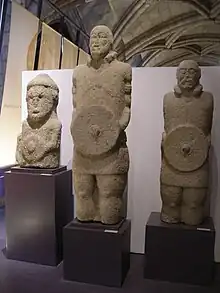The Gallaecian warrior statues are a series of sculptures produced in northwest Iberia (today Galicia and northern Portugal) in the immediate pre-Roman period. Usually associated with the Gallaecian tribal complex they are also sometimes described as statues of Lusitanian, Luso-Gallaecian or Castrejo Culture origin.

Gallaecian Warrior Statues in the Lisbon Museum of Archaeology
Showing armed men slightly larger than natural size,[1] the statues are believed to represent deified local heroes and to date principally from between the 2nd Century BCE to the 1st Century CE.[2]
References
- ↑ "Diretório da Cidade". Informações e Serviços (in Portuguese). Retrieved 9 October 2022.
- ↑ González-Ruibal, Alfredo (20 December 2004). "Artistic Expression and Material Culture in Celtic Gallaecia". E-Keltoi: Journal of Interdisciplinary Celtic Studies. 6. Retrieved 2022-10-08.
This article is issued from Wikipedia. The text is licensed under Creative Commons - Attribution - Sharealike. Additional terms may apply for the media files.